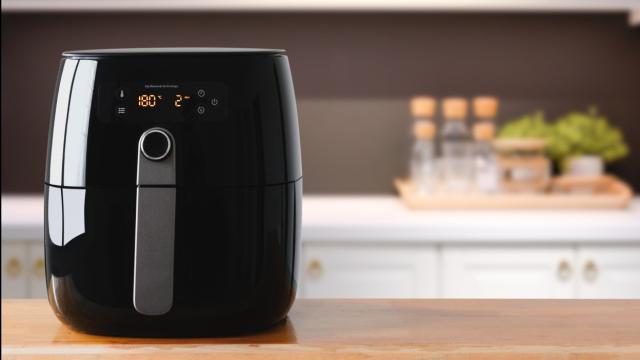As a long-time professional baker, I needed some time to come around to the air fryer—until I realized what it actually was. The air fryer is a boon for home cooks with small jobs that need to be done fast—like reheating leftover french fries or even baking a quick cheesecake—but this handy appliance’s name shrouds it in mystery, or at least misleads newcomers. How does an air fryer even work? Does everything come out fried? It’s actually all pretty simple.
What is an air fryer?
When I think of fried food, I think deep or shallow fried. Maybe it’s breaded or battered, like onion rings or battered fish, or maybe it’s simply dropped in like chicken wings. Whatever it is, the hot oil aggressively cooks the item by being in direct contact with the food. An air fryer is not a deep fryer. It’s not even a shallow fryer. In fact, you might not need any added oil at all.
The name is a cute (albeit confusing) play on how the appliance cooks with deep fryer-like power, but using air. Much to my mom’s surprise, air fryers aren’t fryers at all; they’re powerful and convenient countertop convection ovens.
Convection versus conventional
I remember baking croissants in an industrial convection oven for the first time wondering, “I wish I could have a small one of these at home.” Friends, wishes do come true. Both convection ovens (including air fryers) and conventional ovens (like your stove’s oven) cook by heating up the air. The heating element, whether electric or gas, activates and the enclosed space heats up.
From here, the two ovens take different paths. Conventional ovens have heating elements on the top and bottom, and that’s pretty much where the story ends. The elements heat up the oven, and over time the ambient heat cooks the food.
Your air fryer (and other convection ovens) has one electric coil in the oven space and a fan. When you turn on the appliance, the coil heats up and the fan rapidly circulates the hot air. This difference seems small, but that fan makes a huge difference in cooking time. In a conventional oven, water molecules evaporate away from a piece of chicken on their own time, slowly floating away. In a convection oven’s blast, those molecules get kicked the heck out, with the next molecule right behind it.
Pair this hot-air cyclone with a significantly smaller space than a conventional oven (air fryers baskets are the size of a handbag) and a heat source that’s inches away from the food, and you’ve got rapid convection baking and roasting. This results in fast cooking, crispy, browned crusts and tender interiors. The outcome is close enough to frying but with little to no extra oil, which might be better for your health (and generates far less oil waste).
The pros and cons to air fryers
To our eyes, this rapid convection cooking can look awfully similar to how items can cook in a pool of oil. The hot circulating winds speed up browning and flavor development through the Maillard reaction, and compared to the conventional oven, it wins in the speed category every time. Most things that you can roast in the conventional oven can be cooked and crisped more rapidly in the air fryer, but because of the aggressive heating style you’ll want to decrease the temperature at least 25 degrees, and decrease the cooking time significantly as well. Check here for more helpful tips on air frying without package directions.
Convection cooking is especially effective on snack food that deserves crispy edges and tender interiors, like french fries, frozen spring rolls, crispy tofu, or chicken wings. It’s fabulous for roasting vegetables; just give them a light toss with oil and salt and behold: the quickest roasted potatoes, onions, peppers, or squash. The circulating heat is also perfectly suited for cooking laminated pastries or baked goods that have layers or pockets of butter, like pie crusts or biscuits.
Despite the long list of delicious, crispy foods that fare well in the air fryer, convection ovens aren’t for everything. What shouldn’t you leave outside in a hurricane? Things that can be picked up by the wind. Lightweight food items can get knocked around in an air fryer. I tried crisping up some sliced tortilla shells once, and when I opened the basket they were all folded up and cowering in one corner together. It’s not helpful for “frying” anything that’s been dipped in batter. Fish for fish and chips, or tempura vegetables will still need a deep fryer to turn out right.
Additionally, you’re limited by space. Air fryer baskets are small enough to fit comfortably on your countertop and can be lifted, moved, and stored. This compact size is great for mobility, but lousy for roasting a 15-pound turkey. Sure, I can bake an eight-inch pie or cake in my air fryer, but that’s the size limit, and I can only bake one at a time. There are always going to be times when that big ol’ conventional oven just makes more sense. That said, I’ll never give back my air fryer. It’s perfect for small portions and quick snacks, and damn it, the crispy possibilities are just too great.

Leave a Reply
You must be logged in to post a comment.